Anatomy, growth and function of Coffee plant
VerifiedAdded on 2022/10/18
|10
|1911
|315
AI Summary
Anatomy, growth and function of Coffee plant ANATOMY, GROWTH AND FUNCTION OF COFFEE PLANT ANATOMY, GROWTH AND FUNCTION OF COFFEE PLANT 9 9 Anatomy, growth and function of Coffee plant Name of the student: Name of the university: Authors notes: Coffee plant 2 Taxonomy 2 Discovery of Coffee plant 3 Geographical region 4 Anatomy and Physiology 4 Cultivation 5 Reproductive strategy 6 Uses of coffee 6 Practical impact of coffee in humans 7 Effect of disappearance of the plant
Contribute Materials
Your contribution can guide someone’s learning journey. Share your
documents today.
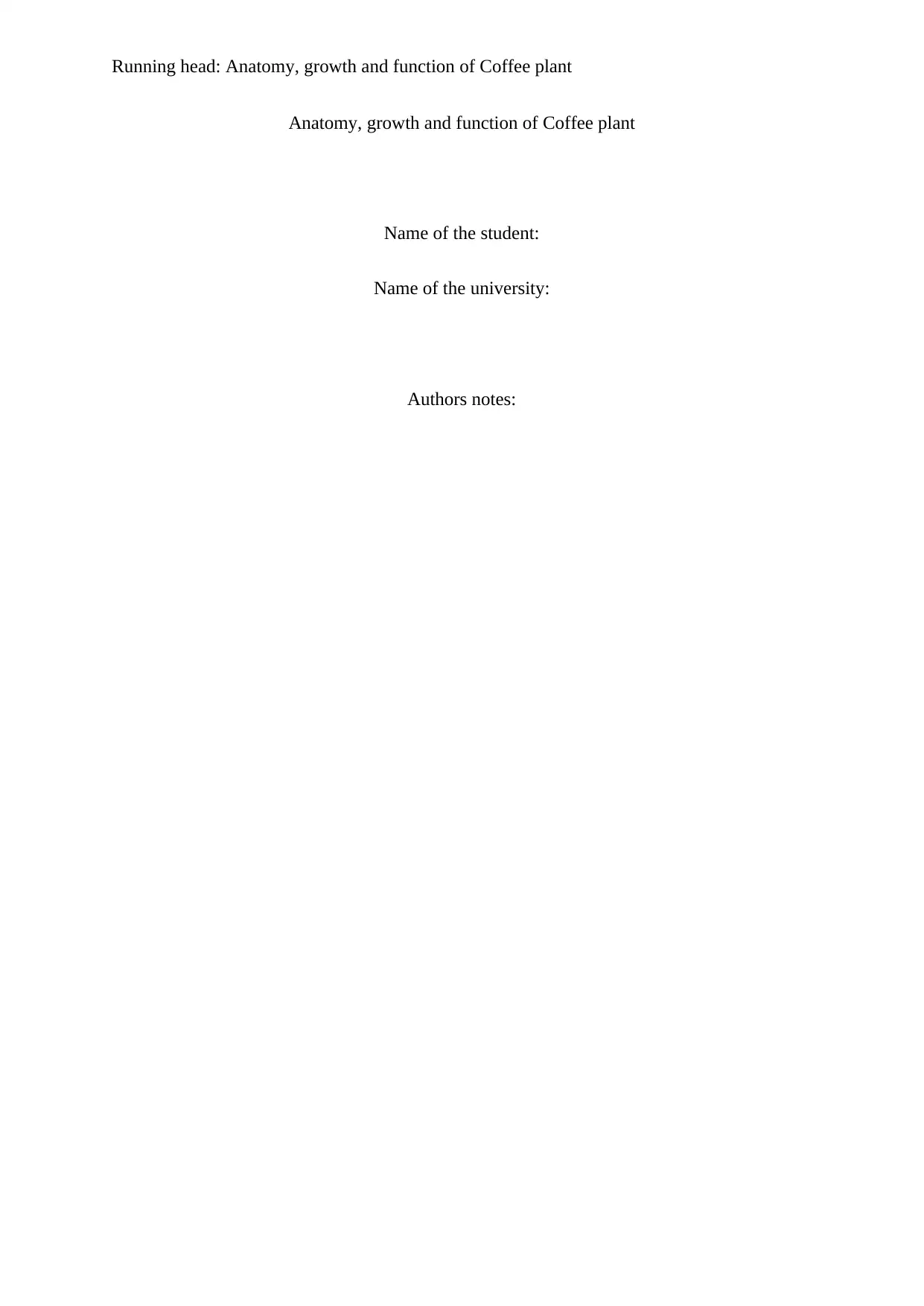
Running head: Anatomy, growth and function of Coffee plant
Anatomy, growth and function of Coffee plant
Name of the student:
Name of the university:
Authors notes:
Anatomy, growth and function of Coffee plant
Name of the student:
Name of the university:
Authors notes:
Secure Best Marks with AI Grader
Need help grading? Try our AI Grader for instant feedback on your assignments.
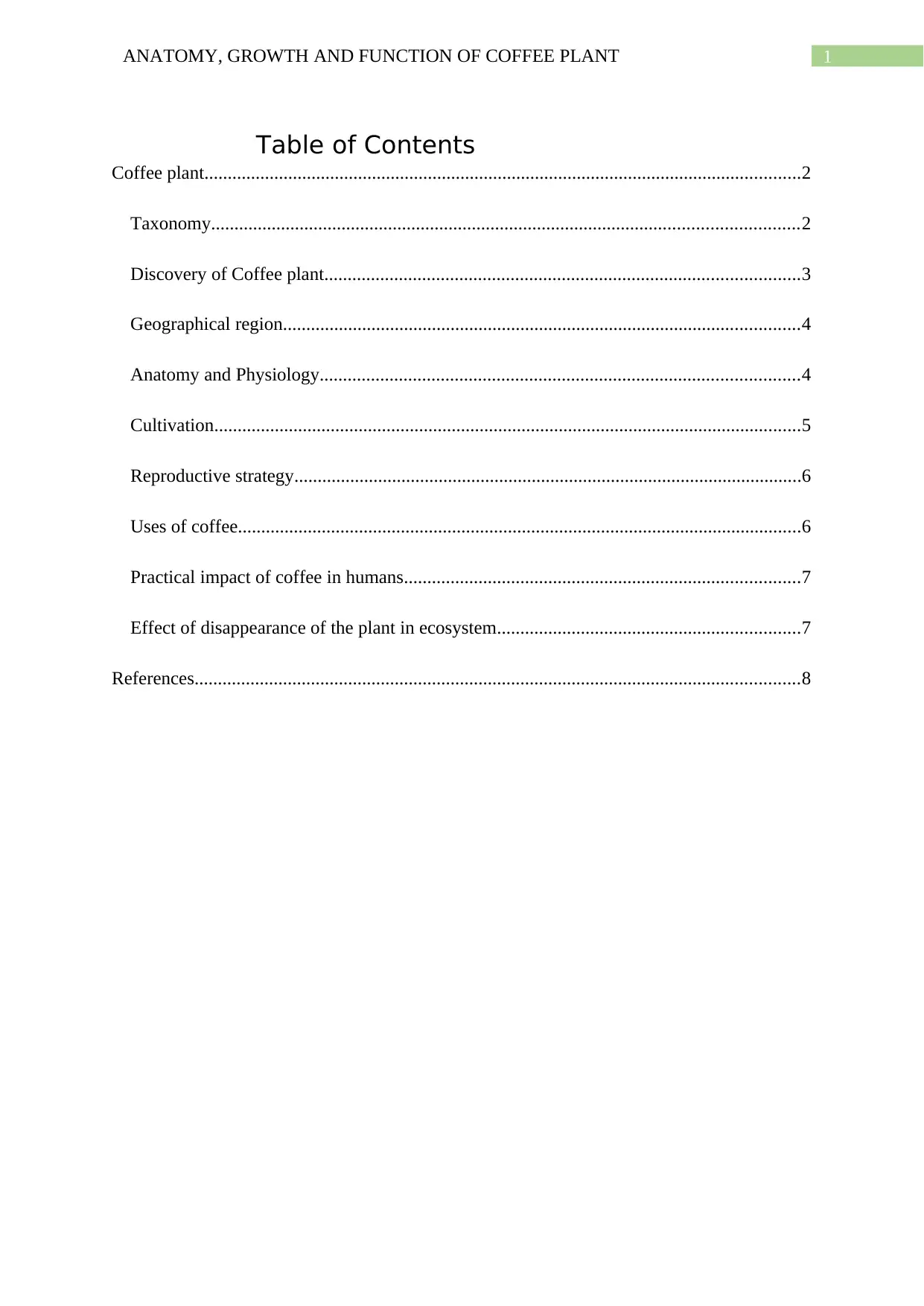
1ANATOMY, GROWTH AND FUNCTION OF COFFEE PLANT
Table of Contents
Coffee plant................................................................................................................................2
Taxonomy..............................................................................................................................2
Discovery of Coffee plant......................................................................................................3
Geographical region...............................................................................................................4
Anatomy and Physiology.......................................................................................................4
Cultivation..............................................................................................................................5
Reproductive strategy.............................................................................................................6
Uses of coffee.........................................................................................................................6
Practical impact of coffee in humans.....................................................................................7
Effect of disappearance of the plant in ecosystem.................................................................7
References..................................................................................................................................8
Table of Contents
Coffee plant................................................................................................................................2
Taxonomy..............................................................................................................................2
Discovery of Coffee plant......................................................................................................3
Geographical region...............................................................................................................4
Anatomy and Physiology.......................................................................................................4
Cultivation..............................................................................................................................5
Reproductive strategy.............................................................................................................6
Uses of coffee.........................................................................................................................6
Practical impact of coffee in humans.....................................................................................7
Effect of disappearance of the plant in ecosystem.................................................................7
References..................................................................................................................................8
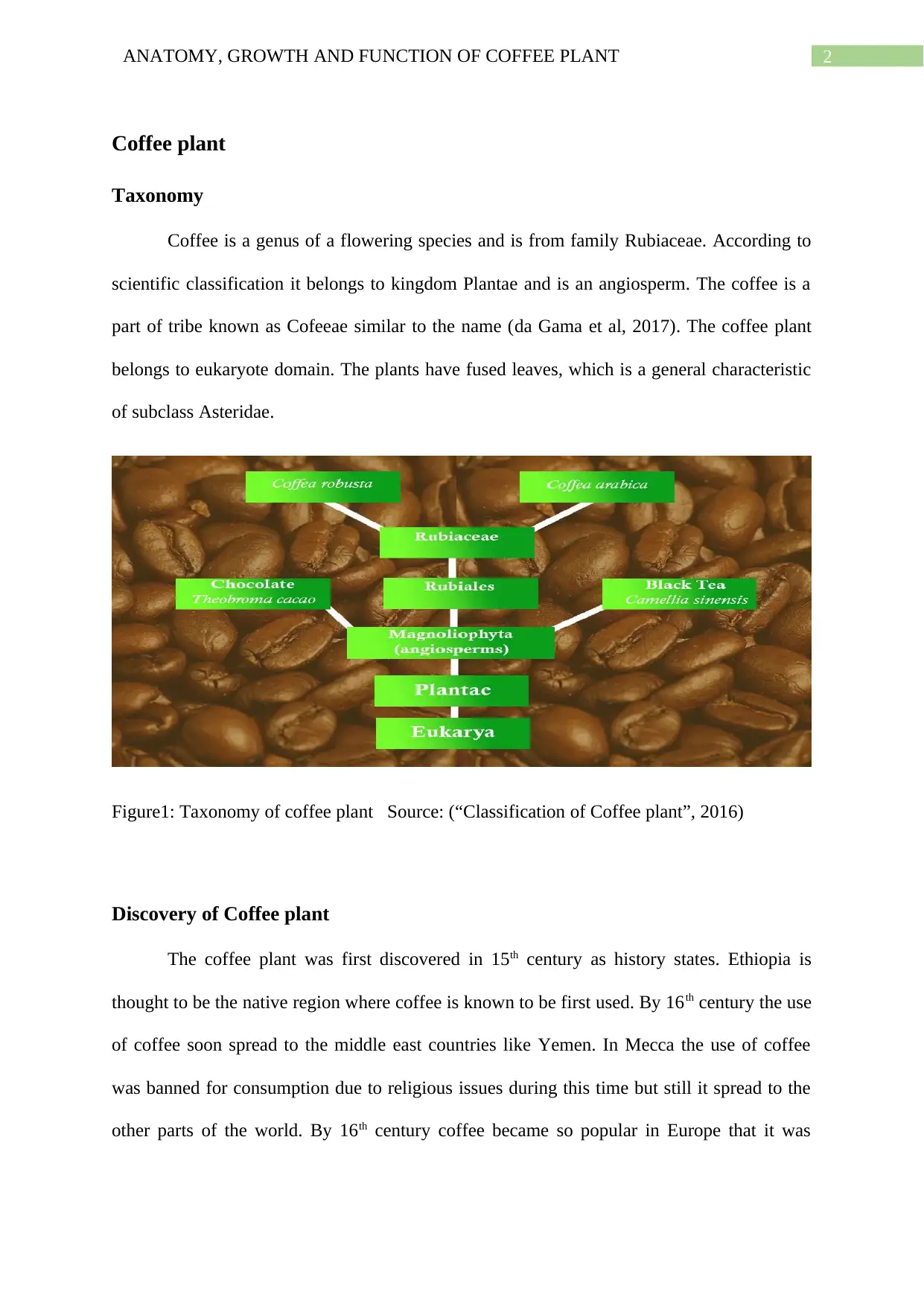
2ANATOMY, GROWTH AND FUNCTION OF COFFEE PLANT
Coffee plant
Taxonomy
Coffee is a genus of a flowering species and is from family Rubiaceae. According to
scientific classification it belongs to kingdom Plantae and is an angiosperm. The coffee is a
part of tribe known as Cofeeae similar to the name (da Gama et al, 2017). The coffee plant
belongs to eukaryote domain. The plants have fused leaves, which is a general characteristic
of subclass Asteridae.
Figure1: Taxonomy of coffee plant Source: (“Classification of Coffee plant”, 2016)
Discovery of Coffee plant
The coffee plant was first discovered in 15th century as history states. Ethiopia is
thought to be the native region where coffee is known to be first used. By 16th century the use
of coffee soon spread to the middle east countries like Yemen. In Mecca the use of coffee
was banned for consumption due to religious issues during this time but still it spread to the
other parts of the world. By 16th century coffee became so popular in Europe that it was
Coffee plant
Taxonomy
Coffee is a genus of a flowering species and is from family Rubiaceae. According to
scientific classification it belongs to kingdom Plantae and is an angiosperm. The coffee is a
part of tribe known as Cofeeae similar to the name (da Gama et al, 2017). The coffee plant
belongs to eukaryote domain. The plants have fused leaves, which is a general characteristic
of subclass Asteridae.
Figure1: Taxonomy of coffee plant Source: (“Classification of Coffee plant”, 2016)
Discovery of Coffee plant
The coffee plant was first discovered in 15th century as history states. Ethiopia is
thought to be the native region where coffee is known to be first used. By 16th century the use
of coffee soon spread to the middle east countries like Yemen. In Mecca the use of coffee
was banned for consumption due to religious issues during this time but still it spread to the
other parts of the world. By 16th century coffee became so popular in Europe that it was
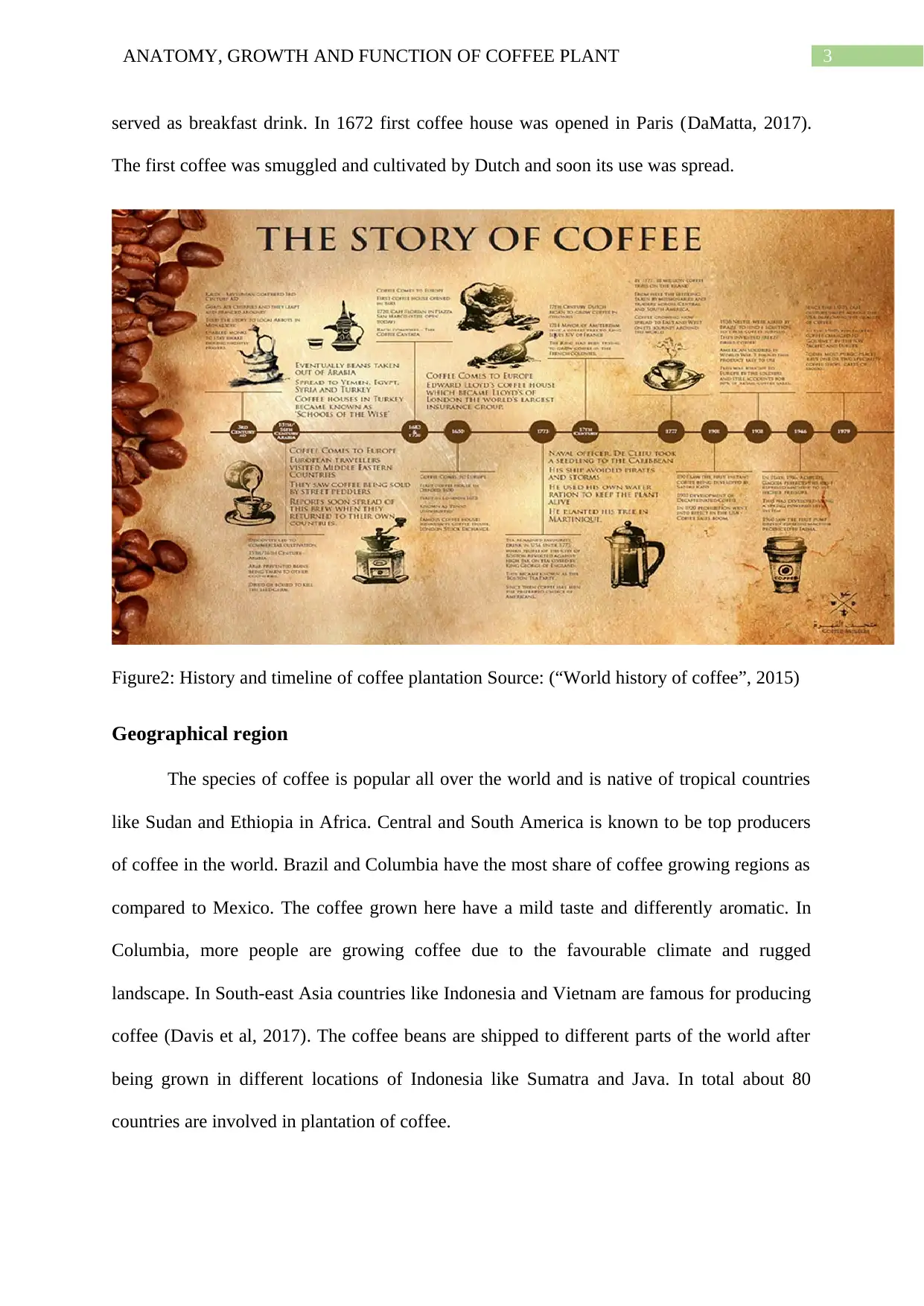
3ANATOMY, GROWTH AND FUNCTION OF COFFEE PLANT
served as breakfast drink. In 1672 first coffee house was opened in Paris (DaMatta, 2017).
The first coffee was smuggled and cultivated by Dutch and soon its use was spread.
Figure2: History and timeline of coffee plantation Source: (“World history of coffee”, 2015)
Geographical region
The species of coffee is popular all over the world and is native of tropical countries
like Sudan and Ethiopia in Africa. Central and South America is known to be top producers
of coffee in the world. Brazil and Columbia have the most share of coffee growing regions as
compared to Mexico. The coffee grown here have a mild taste and differently aromatic. In
Columbia, more people are growing coffee due to the favourable climate and rugged
landscape. In South-east Asia countries like Indonesia and Vietnam are famous for producing
coffee (Davis et al, 2017). The coffee beans are shipped to different parts of the world after
being grown in different locations of Indonesia like Sumatra and Java. In total about 80
countries are involved in plantation of coffee.
served as breakfast drink. In 1672 first coffee house was opened in Paris (DaMatta, 2017).
The first coffee was smuggled and cultivated by Dutch and soon its use was spread.
Figure2: History and timeline of coffee plantation Source: (“World history of coffee”, 2015)
Geographical region
The species of coffee is popular all over the world and is native of tropical countries
like Sudan and Ethiopia in Africa. Central and South America is known to be top producers
of coffee in the world. Brazil and Columbia have the most share of coffee growing regions as
compared to Mexico. The coffee grown here have a mild taste and differently aromatic. In
Columbia, more people are growing coffee due to the favourable climate and rugged
landscape. In South-east Asia countries like Indonesia and Vietnam are famous for producing
coffee (Davis et al, 2017). The coffee beans are shipped to different parts of the world after
being grown in different locations of Indonesia like Sumatra and Java. In total about 80
countries are involved in plantation of coffee.
Secure Best Marks with AI Grader
Need help grading? Try our AI Grader for instant feedback on your assignments.
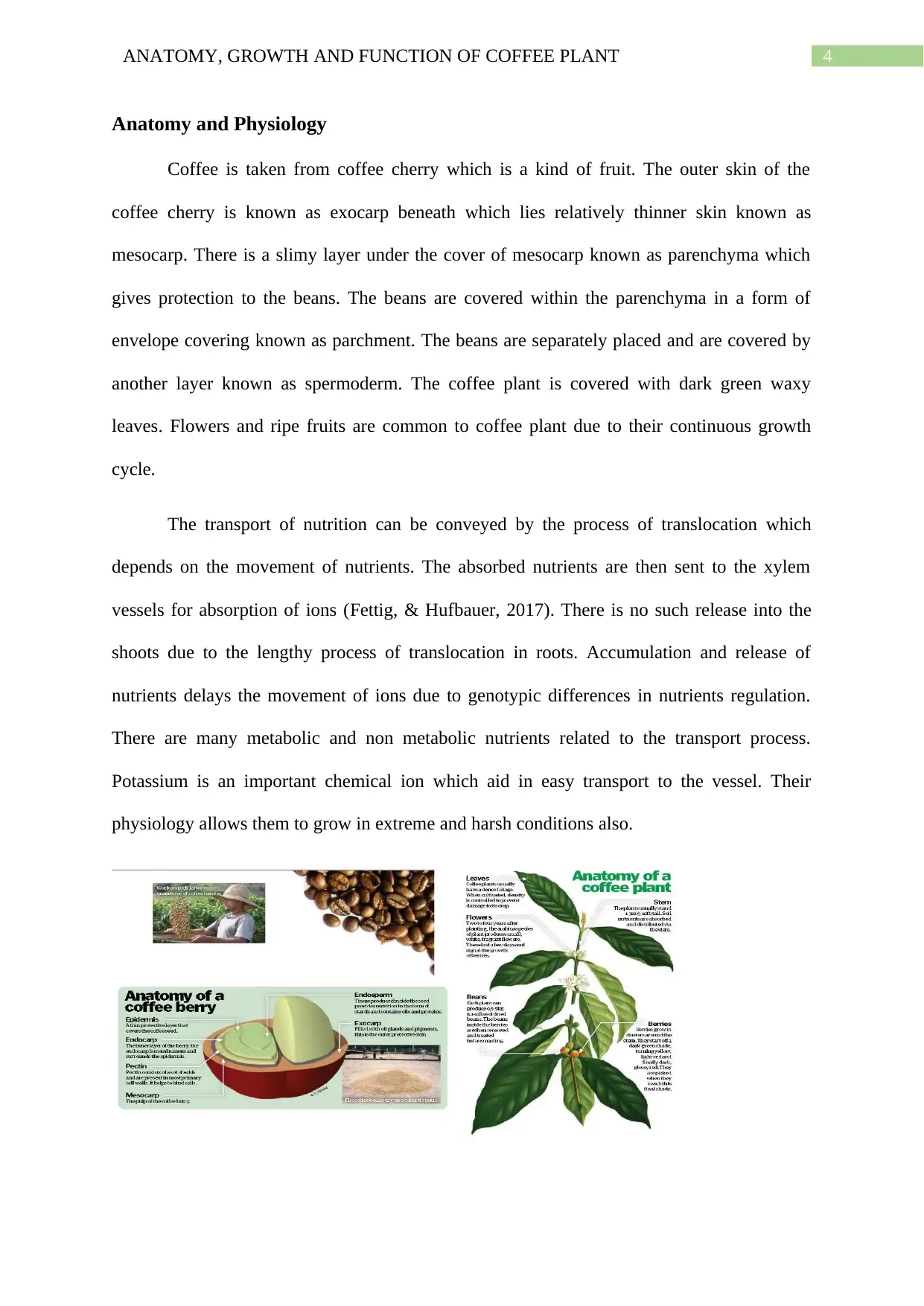
4ANATOMY, GROWTH AND FUNCTION OF COFFEE PLANT
Anatomy and Physiology
Coffee is taken from coffee cherry which is a kind of fruit. The outer skin of the
coffee cherry is known as exocarp beneath which lies relatively thinner skin known as
mesocarp. There is a slimy layer under the cover of mesocarp known as parenchyma which
gives protection to the beans. The beans are covered within the parenchyma in a form of
envelope covering known as parchment. The beans are separately placed and are covered by
another layer known as spermoderm. The coffee plant is covered with dark green waxy
leaves. Flowers and ripe fruits are common to coffee plant due to their continuous growth
cycle.
The transport of nutrition can be conveyed by the process of translocation which
depends on the movement of nutrients. The absorbed nutrients are then sent to the xylem
vessels for absorption of ions (Fettig, & Hufbauer, 2017). There is no such release into the
shoots due to the lengthy process of translocation in roots. Accumulation and release of
nutrients delays the movement of ions due to genotypic differences in nutrients regulation.
There are many metabolic and non metabolic nutrients related to the transport process.
Potassium is an important chemical ion which aid in easy transport to the vessel. Their
physiology allows them to grow in extreme and harsh conditions also.
Anatomy and Physiology
Coffee is taken from coffee cherry which is a kind of fruit. The outer skin of the
coffee cherry is known as exocarp beneath which lies relatively thinner skin known as
mesocarp. There is a slimy layer under the cover of mesocarp known as parenchyma which
gives protection to the beans. The beans are covered within the parenchyma in a form of
envelope covering known as parchment. The beans are separately placed and are covered by
another layer known as spermoderm. The coffee plant is covered with dark green waxy
leaves. Flowers and ripe fruits are common to coffee plant due to their continuous growth
cycle.
The transport of nutrition can be conveyed by the process of translocation which
depends on the movement of nutrients. The absorbed nutrients are then sent to the xylem
vessels for absorption of ions (Fettig, & Hufbauer, 2017). There is no such release into the
shoots due to the lengthy process of translocation in roots. Accumulation and release of
nutrients delays the movement of ions due to genotypic differences in nutrients regulation.
There are many metabolic and non metabolic nutrients related to the transport process.
Potassium is an important chemical ion which aid in easy transport to the vessel. Their
physiology allows them to grow in extreme and harsh conditions also.
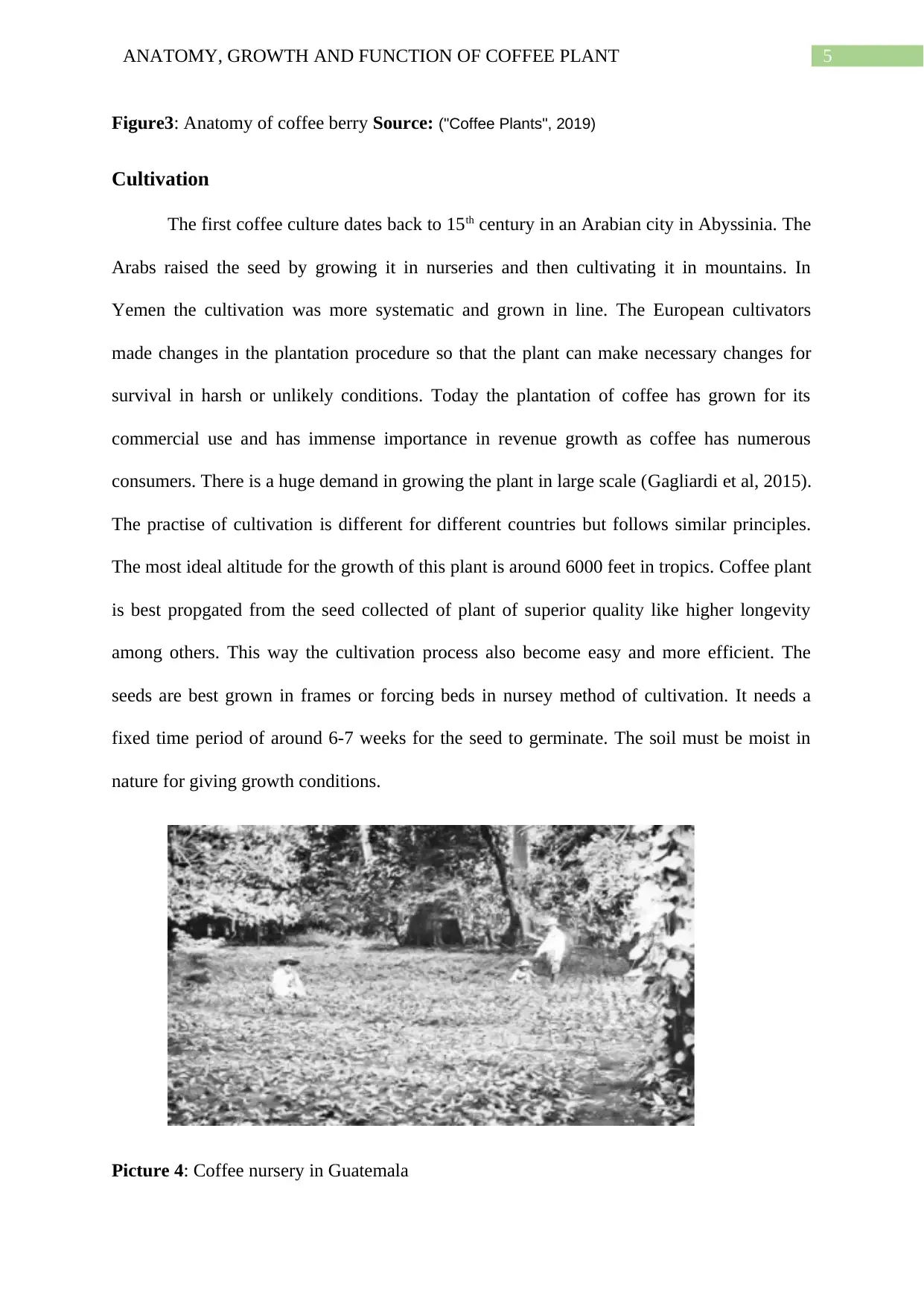
5ANATOMY, GROWTH AND FUNCTION OF COFFEE PLANT
Figure3: Anatomy of coffee berry Source: ("Coffee Plants", 2019)
Cultivation
The first coffee culture dates back to 15th century in an Arabian city in Abyssinia. The
Arabs raised the seed by growing it in nurseries and then cultivating it in mountains. In
Yemen the cultivation was more systematic and grown in line. The European cultivators
made changes in the plantation procedure so that the plant can make necessary changes for
survival in harsh or unlikely conditions. Today the plantation of coffee has grown for its
commercial use and has immense importance in revenue growth as coffee has numerous
consumers. There is a huge demand in growing the plant in large scale (Gagliardi et al, 2015).
The practise of cultivation is different for different countries but follows similar principles.
The most ideal altitude for the growth of this plant is around 6000 feet in tropics. Coffee plant
is best propgated from the seed collected of plant of superior quality like higher longevity
among others. This way the cultivation process also become easy and more efficient. The
seeds are best grown in frames or forcing beds in nursey method of cultivation. It needs a
fixed time period of around 6-7 weeks for the seed to germinate. The soil must be moist in
nature for giving growth conditions.
Picture 4: Coffee nursery in Guatemala
Figure3: Anatomy of coffee berry Source: ("Coffee Plants", 2019)
Cultivation
The first coffee culture dates back to 15th century in an Arabian city in Abyssinia. The
Arabs raised the seed by growing it in nurseries and then cultivating it in mountains. In
Yemen the cultivation was more systematic and grown in line. The European cultivators
made changes in the plantation procedure so that the plant can make necessary changes for
survival in harsh or unlikely conditions. Today the plantation of coffee has grown for its
commercial use and has immense importance in revenue growth as coffee has numerous
consumers. There is a huge demand in growing the plant in large scale (Gagliardi et al, 2015).
The practise of cultivation is different for different countries but follows similar principles.
The most ideal altitude for the growth of this plant is around 6000 feet in tropics. Coffee plant
is best propgated from the seed collected of plant of superior quality like higher longevity
among others. This way the cultivation process also become easy and more efficient. The
seeds are best grown in frames or forcing beds in nursey method of cultivation. It needs a
fixed time period of around 6-7 weeks for the seed to germinate. The soil must be moist in
nature for giving growth conditions.
Picture 4: Coffee nursery in Guatemala
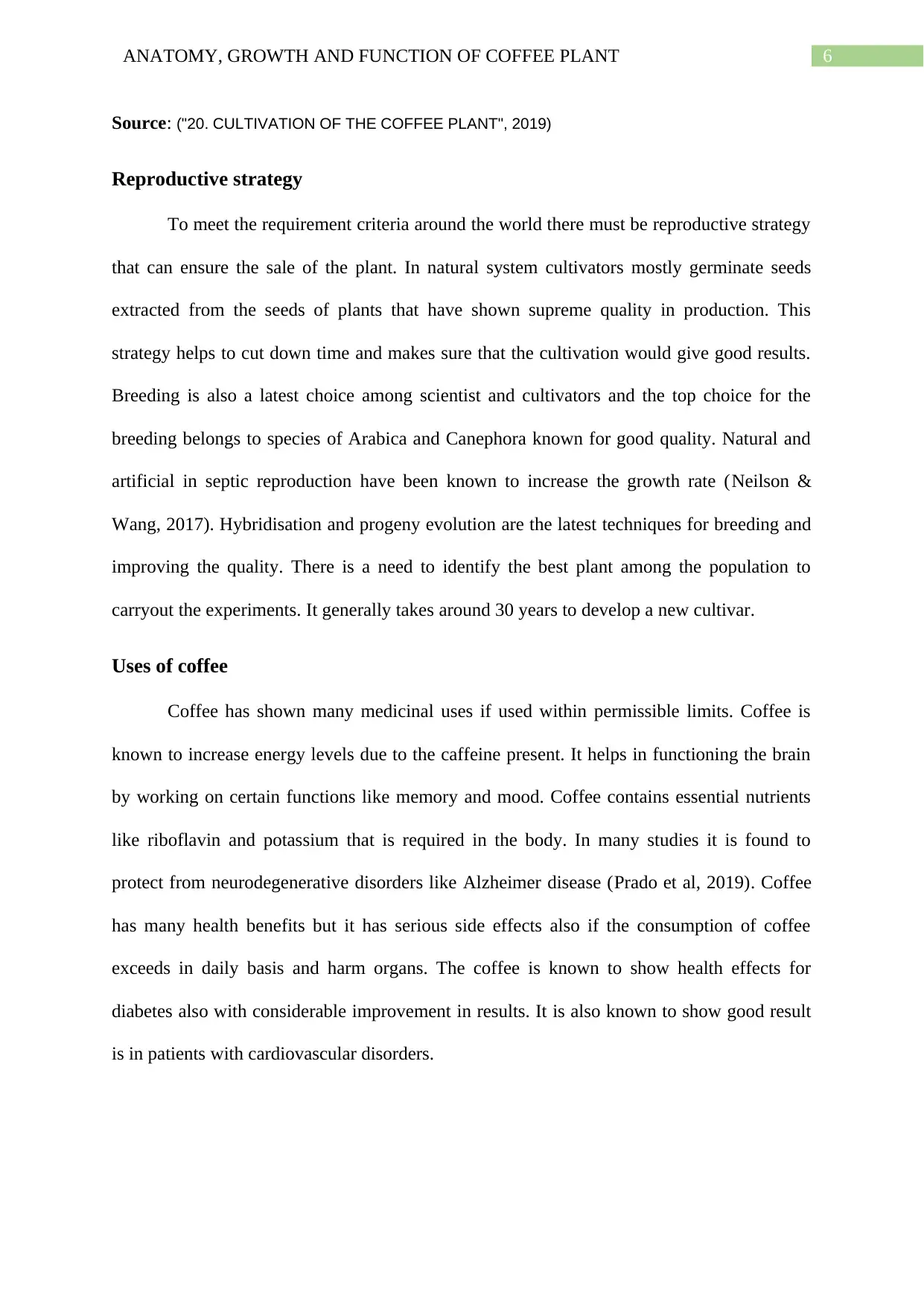
6ANATOMY, GROWTH AND FUNCTION OF COFFEE PLANT
Source: ("20. CULTIVATION OF THE COFFEE PLANT", 2019)
Reproductive strategy
To meet the requirement criteria around the world there must be reproductive strategy
that can ensure the sale of the plant. In natural system cultivators mostly germinate seeds
extracted from the seeds of plants that have shown supreme quality in production. This
strategy helps to cut down time and makes sure that the cultivation would give good results.
Breeding is also a latest choice among scientist and cultivators and the top choice for the
breeding belongs to species of Arabica and Canephora known for good quality. Natural and
artificial in septic reproduction have been known to increase the growth rate (Neilson &
Wang, 2017). Hybridisation and progeny evolution are the latest techniques for breeding and
improving the quality. There is a need to identify the best plant among the population to
carryout the experiments. It generally takes around 30 years to develop a new cultivar.
Uses of coffee
Coffee has shown many medicinal uses if used within permissible limits. Coffee is
known to increase energy levels due to the caffeine present. It helps in functioning the brain
by working on certain functions like memory and mood. Coffee contains essential nutrients
like riboflavin and potassium that is required in the body. In many studies it is found to
protect from neurodegenerative disorders like Alzheimer disease (Prado et al, 2019). Coffee
has many health benefits but it has serious side effects also if the consumption of coffee
exceeds in daily basis and harm organs. The coffee is known to show health effects for
diabetes also with considerable improvement in results. It is also known to show good result
is in patients with cardiovascular disorders.
Source: ("20. CULTIVATION OF THE COFFEE PLANT", 2019)
Reproductive strategy
To meet the requirement criteria around the world there must be reproductive strategy
that can ensure the sale of the plant. In natural system cultivators mostly germinate seeds
extracted from the seeds of plants that have shown supreme quality in production. This
strategy helps to cut down time and makes sure that the cultivation would give good results.
Breeding is also a latest choice among scientist and cultivators and the top choice for the
breeding belongs to species of Arabica and Canephora known for good quality. Natural and
artificial in septic reproduction have been known to increase the growth rate (Neilson &
Wang, 2017). Hybridisation and progeny evolution are the latest techniques for breeding and
improving the quality. There is a need to identify the best plant among the population to
carryout the experiments. It generally takes around 30 years to develop a new cultivar.
Uses of coffee
Coffee has shown many medicinal uses if used within permissible limits. Coffee is
known to increase energy levels due to the caffeine present. It helps in functioning the brain
by working on certain functions like memory and mood. Coffee contains essential nutrients
like riboflavin and potassium that is required in the body. In many studies it is found to
protect from neurodegenerative disorders like Alzheimer disease (Prado et al, 2019). Coffee
has many health benefits but it has serious side effects also if the consumption of coffee
exceeds in daily basis and harm organs. The coffee is known to show health effects for
diabetes also with considerable improvement in results. It is also known to show good result
is in patients with cardiovascular disorders.
Paraphrase This Document
Need a fresh take? Get an instant paraphrase of this document with our AI Paraphraser
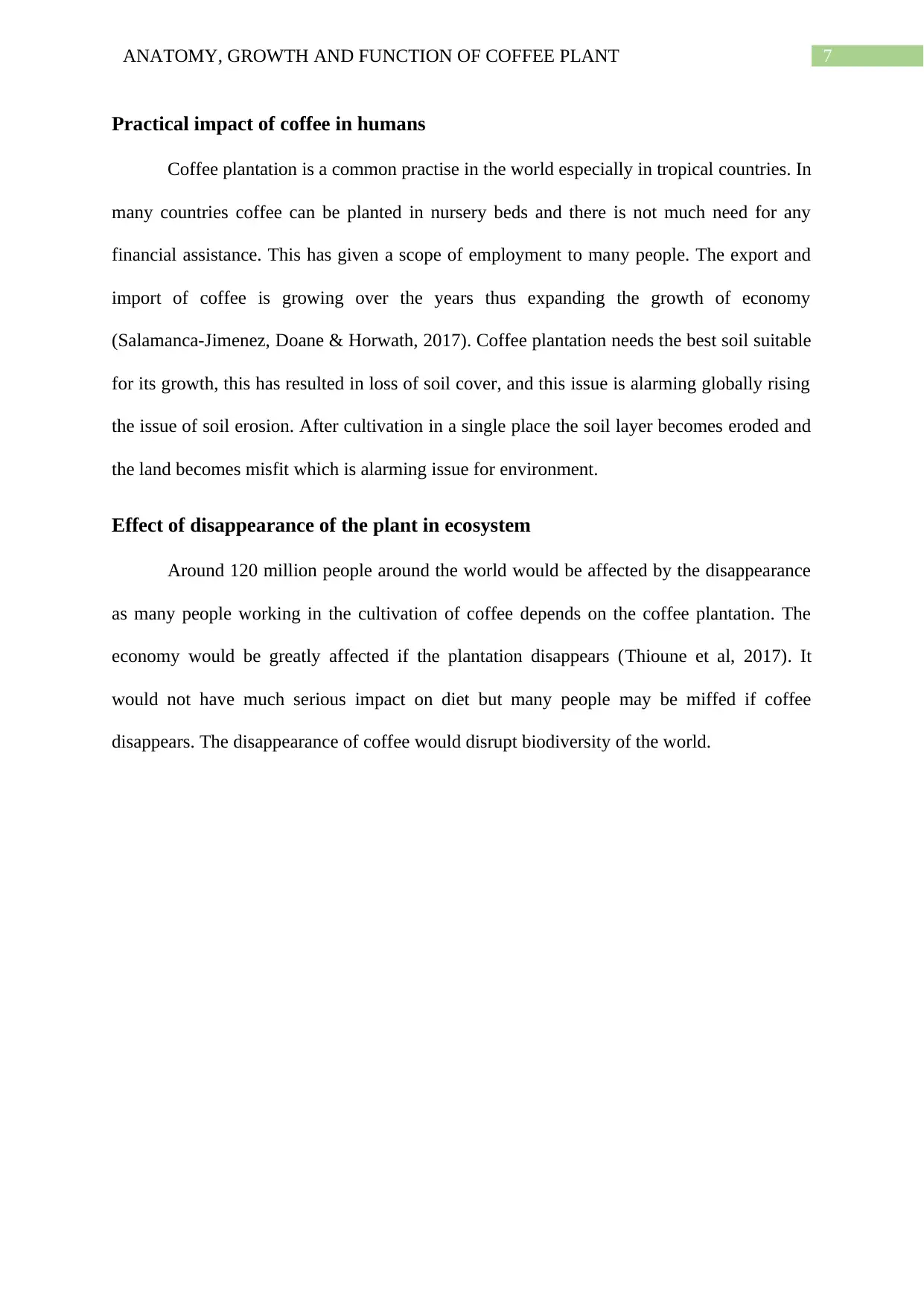
7ANATOMY, GROWTH AND FUNCTION OF COFFEE PLANT
Practical impact of coffee in humans
Coffee plantation is a common practise in the world especially in tropical countries. In
many countries coffee can be planted in nursery beds and there is not much need for any
financial assistance. This has given a scope of employment to many people. The export and
import of coffee is growing over the years thus expanding the growth of economy
(Salamanca-Jimenez, Doane & Horwath, 2017). Coffee plantation needs the best soil suitable
for its growth, this has resulted in loss of soil cover, and this issue is alarming globally rising
the issue of soil erosion. After cultivation in a single place the soil layer becomes eroded and
the land becomes misfit which is alarming issue for environment.
Effect of disappearance of the plant in ecosystem
Around 120 million people around the world would be affected by the disappearance
as many people working in the cultivation of coffee depends on the coffee plantation. The
economy would be greatly affected if the plantation disappears (Thioune et al, 2017). It
would not have much serious impact on diet but many people may be miffed if coffee
disappears. The disappearance of coffee would disrupt biodiversity of the world.
Practical impact of coffee in humans
Coffee plantation is a common practise in the world especially in tropical countries. In
many countries coffee can be planted in nursery beds and there is not much need for any
financial assistance. This has given a scope of employment to many people. The export and
import of coffee is growing over the years thus expanding the growth of economy
(Salamanca-Jimenez, Doane & Horwath, 2017). Coffee plantation needs the best soil suitable
for its growth, this has resulted in loss of soil cover, and this issue is alarming globally rising
the issue of soil erosion. After cultivation in a single place the soil layer becomes eroded and
the land becomes misfit which is alarming issue for environment.
Effect of disappearance of the plant in ecosystem
Around 120 million people around the world would be affected by the disappearance
as many people working in the cultivation of coffee depends on the coffee plantation. The
economy would be greatly affected if the plantation disappears (Thioune et al, 2017). It
would not have much serious impact on diet but many people may be miffed if coffee
disappears. The disappearance of coffee would disrupt biodiversity of the world.
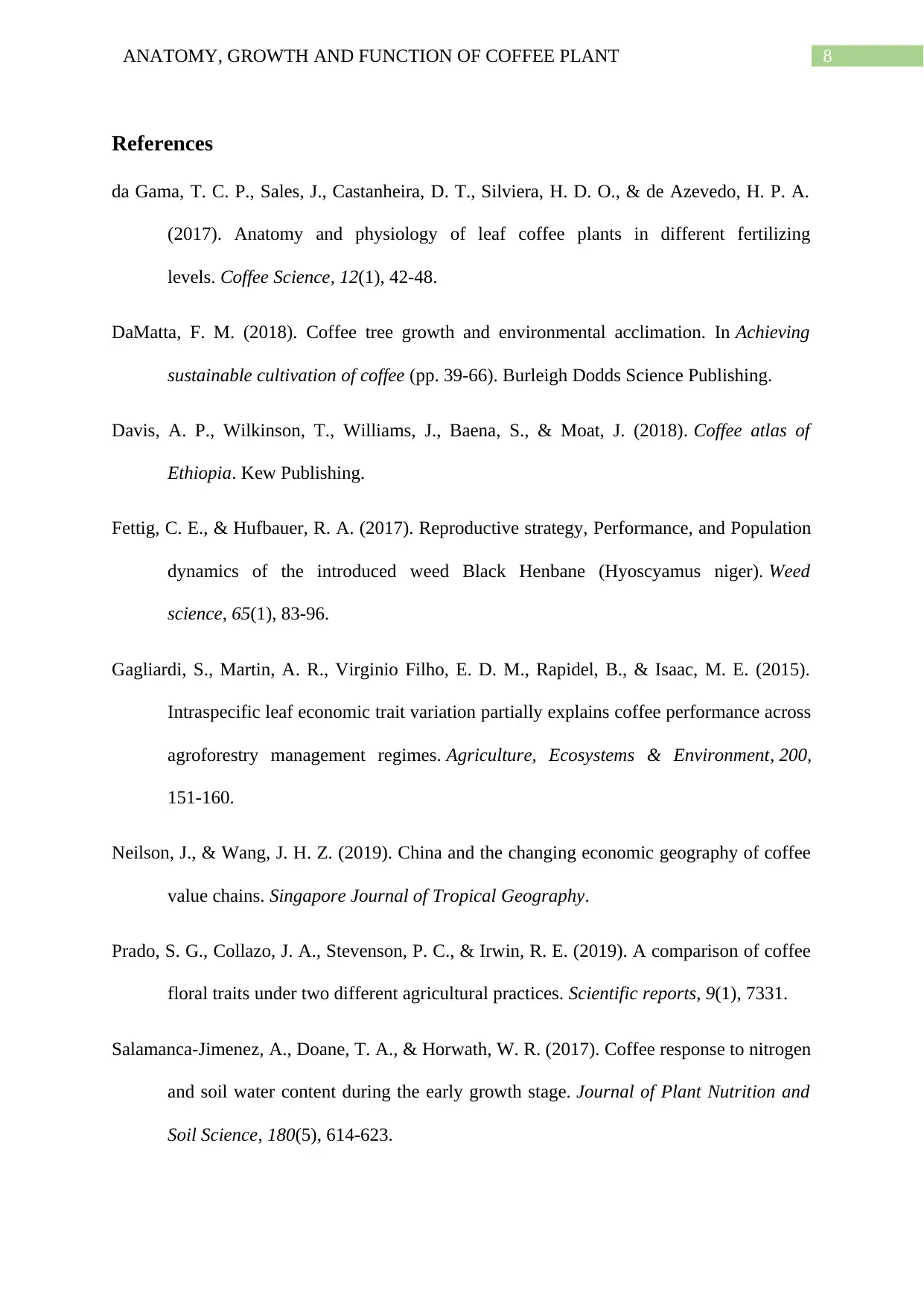
8ANATOMY, GROWTH AND FUNCTION OF COFFEE PLANT
References
da Gama, T. C. P., Sales, J., Castanheira, D. T., Silviera, H. D. O., & de Azevedo, H. P. A.
(2017). Anatomy and physiology of leaf coffee plants in different fertilizing
levels. Coffee Science, 12(1), 42-48.
DaMatta, F. M. (2018). Coffee tree growth and environmental acclimation. In Achieving
sustainable cultivation of coffee (pp. 39-66). Burleigh Dodds Science Publishing.
Davis, A. P., Wilkinson, T., Williams, J., Baena, S., & Moat, J. (2018). Coffee atlas of
Ethiopia. Kew Publishing.
Fettig, C. E., & Hufbauer, R. A. (2017). Reproductive strategy, Performance, and Population
dynamics of the introduced weed Black Henbane (Hyoscyamus niger). Weed
science, 65(1), 83-96.
Gagliardi, S., Martin, A. R., Virginio Filho, E. D. M., Rapidel, B., & Isaac, M. E. (2015).
Intraspecific leaf economic trait variation partially explains coffee performance across
agroforestry management regimes. Agriculture, Ecosystems & Environment, 200,
151-160.
Neilson, J., & Wang, J. H. Z. (2019). China and the changing economic geography of coffee
value chains. Singapore Journal of Tropical Geography.
Prado, S. G., Collazo, J. A., Stevenson, P. C., & Irwin, R. E. (2019). A comparison of coffee
floral traits under two different agricultural practices. Scientific reports, 9(1), 7331.
Salamanca-Jimenez, A., Doane, T. A., & Horwath, W. R. (2017). Coffee response to nitrogen
and soil water content during the early growth stage. Journal of Plant Nutrition and
Soil Science, 180(5), 614-623.
References
da Gama, T. C. P., Sales, J., Castanheira, D. T., Silviera, H. D. O., & de Azevedo, H. P. A.
(2017). Anatomy and physiology of leaf coffee plants in different fertilizing
levels. Coffee Science, 12(1), 42-48.
DaMatta, F. M. (2018). Coffee tree growth and environmental acclimation. In Achieving
sustainable cultivation of coffee (pp. 39-66). Burleigh Dodds Science Publishing.
Davis, A. P., Wilkinson, T., Williams, J., Baena, S., & Moat, J. (2018). Coffee atlas of
Ethiopia. Kew Publishing.
Fettig, C. E., & Hufbauer, R. A. (2017). Reproductive strategy, Performance, and Population
dynamics of the introduced weed Black Henbane (Hyoscyamus niger). Weed
science, 65(1), 83-96.
Gagliardi, S., Martin, A. R., Virginio Filho, E. D. M., Rapidel, B., & Isaac, M. E. (2015).
Intraspecific leaf economic trait variation partially explains coffee performance across
agroforestry management regimes. Agriculture, Ecosystems & Environment, 200,
151-160.
Neilson, J., & Wang, J. H. Z. (2019). China and the changing economic geography of coffee
value chains. Singapore Journal of Tropical Geography.
Prado, S. G., Collazo, J. A., Stevenson, P. C., & Irwin, R. E. (2019). A comparison of coffee
floral traits under two different agricultural practices. Scientific reports, 9(1), 7331.
Salamanca-Jimenez, A., Doane, T. A., & Horwath, W. R. (2017). Coffee response to nitrogen
and soil water content during the early growth stage. Journal of Plant Nutrition and
Soil Science, 180(5), 614-623.

9ANATOMY, GROWTH AND FUNCTION OF COFFEE PLANT
Sauer, J. (2017). Historical geography of crop plants: a select roster. Routledge.
Thioune, E. H., McCarthy, J., Gallagher, T., & Osborne, B. (2017). A humidity shock leads
to rapid, temperature dependent changes in coffee leaf physiology and gene
expression. Tree Physiology, 37(3), 367-379.
Sauer, J. (2017). Historical geography of crop plants: a select roster. Routledge.
Thioune, E. H., McCarthy, J., Gallagher, T., & Osborne, B. (2017). A humidity shock leads
to rapid, temperature dependent changes in coffee leaf physiology and gene
expression. Tree Physiology, 37(3), 367-379.
1 out of 10
Your All-in-One AI-Powered Toolkit for Academic Success.
+13062052269
info@desklib.com
Available 24*7 on WhatsApp / Email
![[object Object]](/_next/static/media/star-bottom.7253800d.svg)
Unlock your academic potential
© 2024 | Zucol Services PVT LTD | All rights reserved.